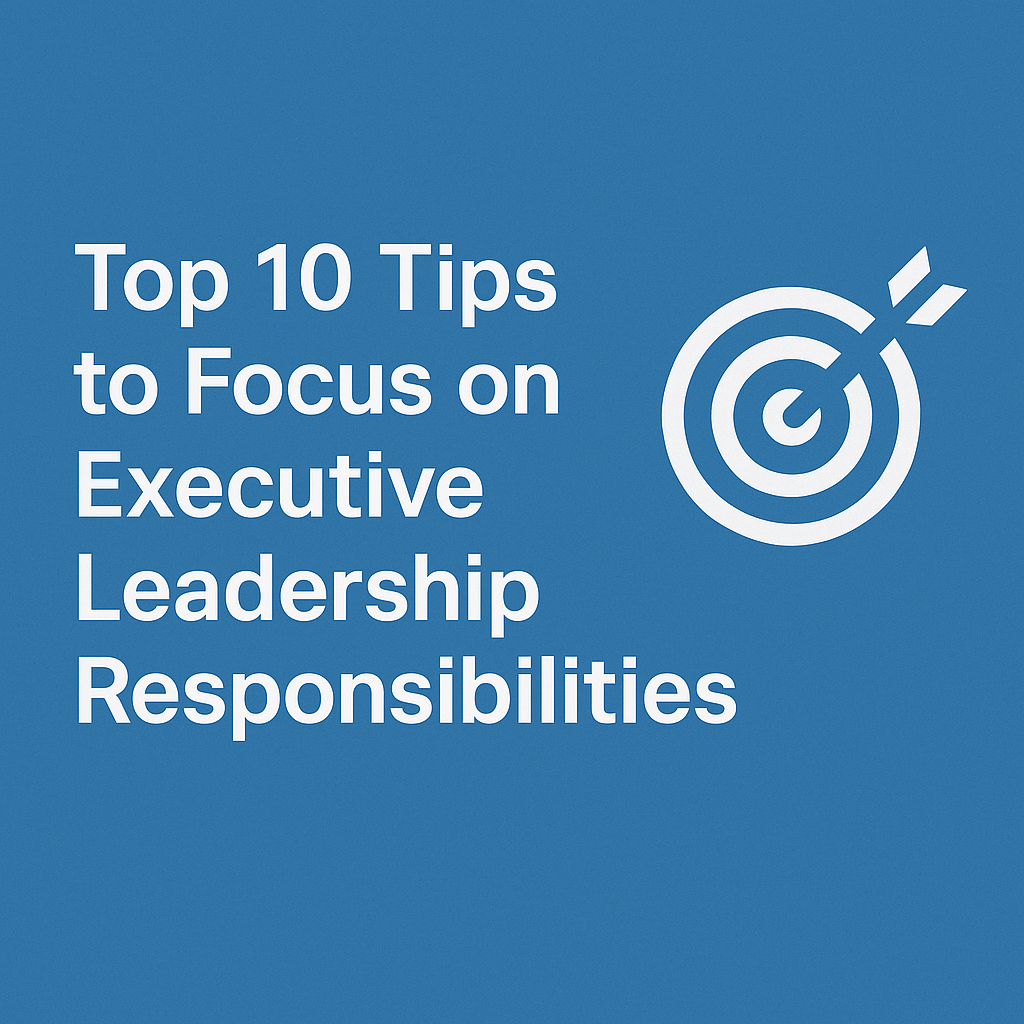Top 10 Tips to Focus on Executive Leadership Responsibilities
To drive organizational success, it’s vital to focus on executive leadership responsibilities. This article outlines the primary responsibilities of executive leaders, encompassing strategic planning, financial oversight, and culture development. By understanding the roles of the CEO, CFO, and COO, you’ll gain insights into effective executive leadership.
Key Takeaways
- Executive leadership roles, including those of CEO, CFO, and COO, are pivotal in steering organizational strategy, managing resources, and fostering innovation to achieve long-term objectives.
- Effective communication of vision, alignment of departmental objectives, and fostering a positive culture significantly enhance employee engagement and organizational success.
- Continuous assessment of risks, financial performance, and performance metrics is essential for informed decision-making, accountability, and sustaining organizational growth.
👉 Ready to sharpen your leadership edge and align your team around a clear vision? Let’s talk strategy. Book your 15-minute call now.
Defining Executive Leadership Roles
Executive leadership roles are crucial in shaping an organization’s strategic direction and performance. Unlike middle managers, executive leaders operate at a broader and more strategic level, focusing on long-term goals and growth. Key responsibilities of executive leaders include:
- Guiding teams
- Focusing on growth goals
- Setting the company vision
- Managing cultural aspects to address organizational challenges in executive leadership positions and the leadership role.
A clear understanding of roles among executive team members fosters better alignment and team member function. This clarity ensures that each executive leader understands their specific duties and how they contribute to the organization’s overall success.
Let’s delve into the distinct roles of the Chief Executive Officer (CEO), Chief Financial Officer (CFO), and Chief Operating Officer (COO) to understand their key responsibilities and contributions.
Chief Executive Officer (CEO)
The Chief Executive Officer (CEO) is a vital member of the company’s executive leadership team, often considered the most senior executive leader. The CEO’s primary responsibilities include:
- Setting the strategic direction
- Leading the executive team
- Engaging with stakeholders
- Fostering innovation
- Ensuring alignment with the organization’s mission and values
The CEO guides strategies and goals within the executive leadership team by communicating a clear vision and purpose.
Stakeholder engagement is a critical role for the CEO, involving:
- Cultivating relationships
- Communicating openly
- Listening to feedback
- Addressing concerns
This engagement ensures that the organization remains aligned with stakeholder expectations and maintains a positive reputation in the broader community. The CEO must balance diverse interests, communicate effectively, and follow up on feedback to effectively manage stakeholder expectations.
Ultimately, the CEO reports to the Board of Directors and other stakeholders who expect transparency and accountability in leadership. This accountability ensures that strategic decisions align with the organization’s mission and values, driving long-term success.
💡 If you’re navigating the challenges of stakeholder alignment or strategic direction, I can help you clarify and lead with confidence. Book a call with me today.
Chief Financial Officer (CFO)
The Chief Financial Officer (CFO) is the highest financial position in a company, responsible for overseeing the financial health by managing financial planning, budgeting, and compliance. The CFO collaborates with other executives to optimize financial performance and shareholder value, providing insights to support strategic decision-making and operational efficiency within the organization.
A key responsibility of the CFO is to ensure wise spending and maintain positive cash flow. Aligning financial strategies with the organization’s goals, the CFO plays a crucial role in driving financial stability and growth.
Chief Operating Officer (COO)
The Chief Operating Officer (COO) focuses on operational excellence and efficiency, with key responsibilities including:
- Overseeing daily operations
- Maintaining alignment with the CEO’s vision
- Ensuring that processes align with strategic goals
- Creating policies for daily operations
- Sharing policies with department managers
Streamlining operations and maintaining operational efficiency, the COO supports the organization’s strategic direction and long-term success.
📈 Operational efficiency doesn’t have to be overwhelming. If you’re ready to streamline your systems, let’s connect. Schedule your session here.
Strategic Vision and Direction
 Executive leaders drive the company’s direction and significantly affect its overall success. They shape the organizational course by turning vision into priorities, defining the company’s mission, values, and strategic objectives to guide its actions. A strategic vision serves as a guiding principle, helping organizations align their teams and functions toward shared long-term objectives.
Executive leaders drive the company’s direction and significantly affect its overall success. They shape the organizational course by turning vision into priorities, defining the company’s mission, values, and strategic objectives to guide its actions. A strategic vision serves as a guiding principle, helping organizations align their teams and functions toward shared long-term objectives.
The quality of decisions made by executive leaders has a significant impact on the success of strategic initiatives. A well-structured decision-making framework, considering data, expert opinions, and strategic objectives, ensures that the organization’s direction remains aligned with its vision.
Setting a Clear Vision
Executive leaders focus on strategies and long-term goals, setting a vision for the future. The Chief Executive Officer (CEO) conveys a sense of purpose. This purpose helps to guide the strategies and goals of the executive leadership team. A strategic vision should be ambitious yet realistic, with a focus on a 3 to 10-year timeline.
Effective communication of a vision requires it to resonate with employees’ daily work, leading to better engagement. Leaders engage others in contributing to the vision by finding ways to get everyone on board. Clear and compelling communication is crucial for effective communication by senior executives.
Aligning Goals and Objectives
Executive teams foster coherence by ensuring that departmental goals align with the company’s overall strategic direction. Effective resource distribution is essential not only for operational efficiency but also for achieving the organization’s overall goals.
Executives define key performance indicators (KPIs) to measure progress toward strategic objectives. Effective performance metrics should be aligned with strategic goals to ensure they truly reflect an organization’s objectives.
🎯 Need help turning your strategy into actionable goals? I’ll walk you through the process. Book your complimentary 15-minute consultation.
Adapting to Market Changes
Regularly assessing market trends enables leadership teams to make timely strategic adjustments. Utilizing diverse data sources enhances the accuracy of decisions by providing a comprehensive view of the situation, thereby improving informed decision-making.
Executives must develop a keen awareness of both emerging and existing risks that may hinder their organization’s objectives. Awareness of internal dynamics and external market conditions enables executives to navigate organizational change effectively.
Leading People and Culture

Effective executive leaders can motivate employees, enhance organizational culture, build innovative ideas, and realize the company’s vision. A strong organizational culture has a significant impact on employee motivation and retention. Senior executives set the tone for behaviour, trust, and performance within the organizational culture.
Shaping a positive work environment, fostering employee engagement, and building an inclusive culture, executive leaders have a significant influence on organizational success. Celebrating team achievements and fostering trust, support, encouragement, and appreciation for employees are essential for creating a positive workplace.
Building a Positive Work Culture
Building trust and rapport within teams can be achieved through team-building activities and the use of collaborative tools. Promoting transparency among team members fosters stronger workplace relationships and enhances trust among team members. Executive leaders aim to enhance work productivity and engagement by empowering teams and fostering a positive culture through team development.
Encouraging a growth mindset through continuous learning and a supportive environment is crucial for fostering employee engagement during challenging times. Providing constructive feedback demonstrates care about improvement and fosters respect within the team.
Frequent feedback sessions are increasingly preferred over annual reviews as they help enhance employee performance.
🤝 Culture eats strategy for breakfast. If your team isn’t thriving, let’s explore what’s holding them back. Book your call here.
Promoting Professional Development
Effective executive teams promote learning and development to ensure employees have the skills needed for future challenges. Effective executive leaders commit to ongoing development through reading, training, and staying current on industry trends.
Leaders provide opportunities for continuous learning to enhance skills and support employee career growth. Periodic assessments of performance metrics help executive teams provide constructive feedback, thereby enhancing employee skills.
Encouraging Open Communication
Executive leaders set a positive example for communication that influences employee attitudes and behaviours. Transparent communication from leaders about the change process fosters trust and cooperation among employees.
Effective communication is vital in leadership as it influences organizational culture and employee engagement. Open communication leads to a more engaged workforce, where feedback is valued and encourages innovation.
Effective Decision Making

Timely decision-making influences broad and long-lasting implications for organizations. Ineffective decisions can result in lost revenue, decreased market share, and increased employee turnover. Executive teams must gather information and consider various options before making decisions.
Self-awareness enables leaders to understand their emotions, thereby enhancing their decision-making and relationships. Continuous self-reflection enables leaders to identify strengths and weaknesses, improving decision-making and personal development. Understanding one’s reactions in professional settings is fundamental for effective leadership.
Gathering Relevant Information
Effective leadership teams address strategic leadership challenges by:
- Conducting regular strategic reviews.
- Fostering open communication within the senior leadership team to share insights and data more effectively.
- Gathering relevant information to enable executive leadership to make informed decisions.
- Collecting data from diverse sources to enhance the quality of decisions made by executive leaders.
This approach ensures well-rounded options and informed strategic decisions.
Valuing Diverse Perspectives
Including discussions from multiple perspectives and diverse opinions is essential for effective decision-making. Leaders must evaluate complex information and competing priorities to make informed decisions effectively. Executive teams utilize critical thinking by assessing options, reviewing consequences, and adjusting direction in their decision-making.
Involving a range of viewpoints fosters innovative solutions and prevents groupthink in decision-making processes. This diversity of thought enhances the robustness and creativity of strategic decisions.
Implementing Decisions
The strategic process is a continuous process that involves collecting data, facilitating dialogue, and making informed decisions. Executing decisions effectively is crucial in guiding organizational direction and achieving strategic thinking outcomes.
Clear communication of decisions ensures that all relevant stakeholders understand the organization’s strategic direction and their roles within it. This clarity fosters alignment and commitment to the strategic goals.
🧠 Smart decisions require clarity, not guesswork. Let’s design a decision-making framework that works for you. Schedule a chat.
Financial Oversight and Resource Allocation
The CFO plays a crucial role in assessing financial risks and ensuring the effective allocation of resources to support strategic goals. Effective resource allocation by the CFO is vital for optimizing performance and aligning with the organization’s strategic initiatives. Executive teams must effectively allocate resources to maximize organizational productivity.
Financial oversight and responsible allocation are essential for achieving the organization’s long-term objectives. This ensures financial stability and supports strategic growth.
Budget Management
The CFO plays a pivotal role in leading financial strategy, which includes overseeing the creation and management of budgets and financial reports. Zero-Based Budgeting (ZBB) is a financial planning strategy. In this approach, every department begins with a zero base for each budgeting period.
Under Zero-Based Budgeting, departments are required to justify all expenses as if they were brand new. This approach ensures that resources are allocated efficiently and aligned with strategic priorities.
Optimizing Resource Allocation
Efficiently distributing resources is vital for organizational success. Organizations face challenges such as balancing short-term needs with long-term investments, avoiding waste, and managing priorities in resource allocation. Effective resource allocation ensures that financial resources are distributed efficiently to maximize productivity and achieve organizational goals.
Monitoring Financial Performance
Regular monitoring of financial performance is essential for executive leaders to ensure organizational viability and success. Effective budget management involves overseeing the creation and management of budgets to ensure financial stability and support strategic initiatives.
Defining key performance indicators (KPIs) is crucial for measuring progress towards strategic goals and assessing financial performance. Regular performance reviews should be conducted to assess financial performance and identify areas for necessary adjustments.
Risk Management and Compliance
Effective risk management is essential for business continuity. Risk management is critical for executives to ensure organizational stability and performance. Executive leaders are responsible for identifying and assessing potential risks within the organization.
Ensuring compliance with regulations is a vital aspect of the overarching risk management strategy. This ensures that the organization operates within legal and ethical boundaries.
Identifying Potential Risks
Executives must identify potential risks impacting objectives and continuity to safeguard the organization’s future. It is crucial for executives to constantly assess external threats and internal vulnerabilities to manage risk and reputation effectively. A misstep at the executive level can have company-wide consequences, underscoring the importance of proactive risk identification.
Continuous assessment of both internal and external risks is necessary to ensure that the organization remains resilient and adaptable.
Developing Risk Mitigation Strategies
Implementing a risk management framework, conducting regular assessments, and promoting a risk-aware culture are essential steps in addressing risks. Essential qualities for executives managing risk include judgment, resilience, and stakeholder management.
Creating strategies to minimize the impact of identified risks is crucial for organizational resilience. Fostering a culture that encourages risk awareness helps organizations to identify and mitigate potential threats proactively.
Ensuring Regulatory Compliance
The executive team is responsible for:
- Maintaining legal and ethical standards within the organization.
- Ensuring that operations comply with these boundaries.
- Framing appropriate consequences for non-compliance to support accountability within the organization.
- Performing regular audits to ensure compliance.
- Implementing training programs to uphold high standards of corporate governance.
Innovation and Transformation

Innovation is crucial for organizational success and must be actively promoted by executive leaders. Nurturing continuous growth and adaptation among the executive team is essential for driving innovation. Transformative leaders play a significant role in leading change management initiatives within their organizations.
Executives face complexities from digital transformation and market changes, which require effective leadership to navigate. By fostering a culture of innovation and leading change initiatives, executives can drive long-term growth and success.
Fostering a Culture of Innovation
Leaders who prioritize continuous learning are more likely to cultivate an innovative environment. Fostering a culture of innovation is essential for organizations to remain competitive and relevant. Encouraging creativity and experimentation enables employees to explore new ideas, resulting in continuous improvement.
Together, these practices create an environment where innovation thrives and drives organizational success.
🚀 Innovation shouldn’t be accidental. Let’s create systems that empower your team to think forward. Book your call with me now.
Leading Change Initiatives
Effective executives may need to introduce new product lines, establish new departments, or invest in new processes to demonstrate the benefits of change and address new challenges. Effective business leaders lead effectively; they adapt their action plans to align with new circumstances.
Leaders use problem-solving skills and leadership skills to navigate obstacles that arise during organizational change. This adaptability ensures that change management leaders are successful and aligned with strategic goals.
Leveraging Technology
A key responsibility of executive leadership teams is to incorporate new technologies. This helps improve operations and drive innovation. Executive leadership teams prioritize staying current with fast-paced technological advancements. They also manage costs and work to ensure user adoption.
Nontechnical C-suite executives need to understand emerging technologies, data-driven tools, and cybersecurity trends. Leadership teams ensure technology aligns with strategic goals by staying informed about industry trends and investing in training programs.
Emotional Intelligence and Self-Awareness
Emotional intelligence (EQ) in executive leadership is the ability to understand and manage one’s own emotions and those of others. Self-awareness is crucial for executives, as it enables them to manage relationships intentionally and establish credibility. Emotional intelligence is a critical interpersonal skill that enables leaders to effectively coach teams, manage stress, and foster collaboration, thereby enhancing their executive skills.
Developing emotional intelligence and self-awareness enhances leadership effectiveness and builds stronger relationships within teams.
Understanding Emotions
Self-awareness allows leaders to recognize their emotions and understand how these feelings influence their team’s performance. Important key skills associated with self-awareness for executive leaders include essential skills such as:
- Empathy
- Adaptability
- Patience
- Kindness
Leaders build trust within their teams by actively listening to their concerns and ideas. Executive presence and communication set an example for colleagues, inspiring support for the organization’s vision and values, reflecting a strong leadership style.
Enhancing Communication Skills
Effective communication in leadership inspires employees and supports the sharing of information and expectations. A key quality required for effective communication by C-suite leaders is the ability to convey, explain, and persuade clearly and persuasively.
Effective leadership communication requires the ability to listen and convey information clearly and actively. This ensures that all team members are aligned and engaged with the organization’s goals.
Developing Self-Awareness
Self-awareness is crucial for effective leadership, enabling leaders to reflect on their strengths and areas for improvement. Understanding and managing one’s own emotions, as well as recognizing those of others, helps build trust and rapport within teams.
Using emotional intelligence effectively enhances communication, facilitating conflict resolution and inspiring team collaboration. Continuous reflection on both emotional awareness and communication skills promotes a leader’s growth and effectiveness.
Succession Planning and Talent Development
Successful succession planning ensures an organization is prepared to meet future success by systematically developing potential candidates. Succession planning is crucial for ensuring organizational continuity and preparing for future leadership transitions. A key responsibility of senior executives in talent development is identifying potential and mentoring emerging executives.
Executive leaders must set a vision, develop a strategy, manage talent, and shape the culture to ensure the growth of new management leaders. Challenges in succession planning can include retaining top talent, providing effective training, and ensuring smooth transitions.
To overcome succession planning obstacles, organizations can implement mentorship programs and offer continuous professional development opportunities for career advancement.
Identifying High-Potential Employees
Recognizing high-potential employees early allows organizations to tailor development opportunities to fit specific market needs. Executives identify high-potential talent through early identification and by providing opportunities for growth.
Nurturing future leaders can involve mentoring, leadership programs, workshops, and cross-functional projects. This ensures a pipeline of capable leaders for the organization’s future.
Providing Mentorship and Coaching
Mentorship and coaching provide critical support for emerging leaders. Through real-world situations, mentorship helps refine skills essential for leadership roles. This hands-on approach ensures that emerging leaders are well-prepared to take on executive positions and drive the organization’s success.
Planning for Smooth Transitions
Establishing clear succession plans helps organizations minimize disruptions during leadership changes. Effective communication and planning ensure that transitions are smooth and do not negatively impact the organization’s performance.
A well-defined succession plan enables organizations to navigate leadership changes with confidence and maintain continuity, thereby ensuring the organization’s future stability.
Measuring Performance and Accountability
Tracking performance is crucial for executive teams to ensure accountability and drive results. Executive teams must track performance consistently to ensure accountability and drive results. Effective budget management involves continuously assessing financial forecasts and performance against the budget.
Setting clear performance metrics and conducting regular reviews fosters a culture of sustained performance, continuous improvement, and accountability within the organization.
Setting Performance Metrics
Executive teams establish key performance indicators (KPIs). These KPIs help measure progress toward achieving strategic objectives. Leadership teams often employ a balanced scorecard approach to manage performance metrics. Data-driven decision-making enhances choices informed by evidence. This approach ensures that performance metrics are aligned with the organization’s strategic goals.
Regular Performance Reviews
Executive teams regularly track performance metrics to assess organizational and the company’s performance. Regular performance reviews are crucial for executive leadership as they provide structured opportunities to assess outcomes and align with strategic goals.
Feedback from performance reviews helps identify areas for improvement, thereby enhancing overall organizational effectiveness. Conducting regular performance reviews fosters a culture of continuous improvement and accountability within the organization.
Fostering Accountability
Final responsibility for decisions and acknowledgment of errors is crucial in executive leadership. Senior leaders responsible for a strong culture of accountability promote ownership among executives for their actions.
Teams at the leadership level promote accountability by helping managers set expectations and take ownership. The executive is ultimately responsible for the consequences of a failed marketing campaign under their leadership. When an executive attempts to shift blame for mistakes, it erodes trust and undermines respect.
Summary
Executive leadership is a multifaceted endeavour that requires a clear understanding of roles, strategic vision, effective decision-making, financial oversight, risk management, innovation, emotional intelligence, succession planning, and performance measurement. By focusing on these key areas, executive leaders can drive their organizations towards sustained success and create a positive and engaging work culture.
In summary, the top 10 tips to focus on executive leadership responsibilities include defining roles clearly, setting a strategic vision, aligning goals, adapting to market changes, leading people and culture, making effective decisions, overseeing finances, managing risks, fostering innovation, and measuring performance. These tips are not just theoretical; they are grounded in practical insights and real-world experiences.
By implementing these strategies, executive leaders can enhance their leadership skills, build stronger teams, and achieve long-term organizational success.
📞 Reading about leadership is great—transforming your leadership is better. If you’re ready to lead with greater clarity, purpose, and momentum, book your free 15-minute call today.
Frequently Asked Questions
What is the primary role of a Chief Executive Officer (CEO)?
The primary role of a CEO is to set the strategic direction and lead the executive team while engaging with stakeholders to ensure alignment with the organization’s mission and values. This leadership is essential for fostering innovation and guiding the company toward its goals.
How does a CFO contribute to an organization’s financial health?
A CFO significantly contributes to an organization’s financial health by overseeing financial planning, budgeting, and compliance, while also collaborating with executives to enhance financial performance and maintain positive cash flow. This strategic oversight ensures wise spending and overall fiscal responsibility.
Why is setting a clear vision important for executive leadership?
Setting a clear vision is essential for executive leadership as it fosters a sense of purpose, aligns strategies, and ensures that all employees understand and commit to the organization’s long-term objectives. This alignment significantly enhances overall organizational effectiveness and cohesion.
What role does emotional intelligence play in executive leadership?
Emotional intelligence is vital in executive leadership, as it enables leaders to manage their own emotions and understand the emotions of others, thereby enhancing trust, communication, and collaboration within teams. This foundation is essential for effective leadership and team dynamics.
How can executive leaders ensure effective risk management?
Executive leaders can ensure effective risk management by identifying potential risks, developing strategies to mitigate them, fostering a culture of risk awareness, and ensuring compliance with relevant regulations. This comprehensive approach strengthens the organization’s resilience against unexpected challenges.




